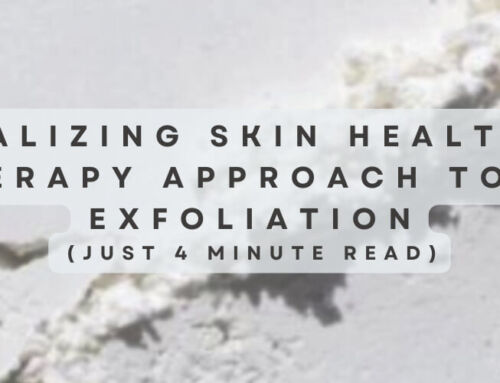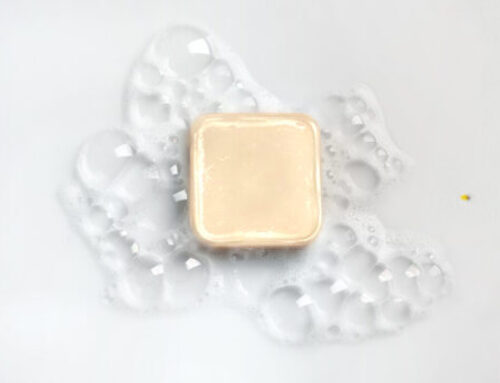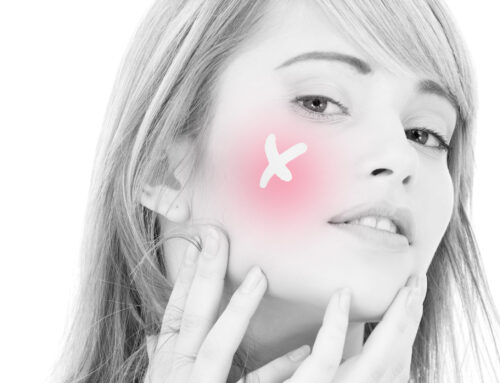It’s time to put down the excess of moisturizers, creams, and mists—your skin already has brilliant barriers that control exactly what it needs on its own, and that includes regulating moisture levels. The hero to your naturally soft, supple skin? The aptly named, Natural Moisturizing Factor—also known as NMF.
In normal skin, there are a variety of, well, factors that contribute to how your skin produces NMF to keep things moisturized on its own. And if you’re not feeling hydrated, no matter how much you slather on your fav topical cream? I hate to break it to ya: your skin isn’t producing these much-needed key barriers.
But here’s the good news: hope comes in the form of corneotherapy (which does include moisturizers, but the kind your skin loves). So if you or your clients suffer from a skin condition or generalized flaky, dry skin, or you just want to get geeky about skin biology, let’s dive deep dive into NMF.
But First, a Brief Scientific History
Studies that reported the discovery of the NMF first referred to it as “water-soluble compounds.” While technically true, the name didn’t quite summarize the importance of its role (which is pretty important!). Other studies referred to it as “naturally occurring humectants,” (getting better), as most labels started pointing to its involvement in binding water in the stratum corneum.
The term “natural moisturizing factor,” however, was finally coined in 1959 by Jacobi and colleagues, and the name is the one that eventually stuck!
What Is It, Anyway?
First, we should look at where it is. Our skin has three basic layers: hypodermis (deepest layer), dermis (second layer), and epidermis (the outer layer) AKA the Stratum Corneum (SC). The SC is decked out with all the latest “tech,” so-to-speak, to protect you from the outside world—complete with a built-in permeability barrier, an antimicrobial barrier, a UV-ray filter and more. Read all about the skin barrier here.
Here’s a summary: The top-most layer of the SC is often referred to as a brick-and-mortar structure, the bricks being the corneocytes. The mortar? Specialized lipids—ceramide, cholesterol and free fatty acids. They are packed tightly to create the main barrier against water loss.
Case in point:
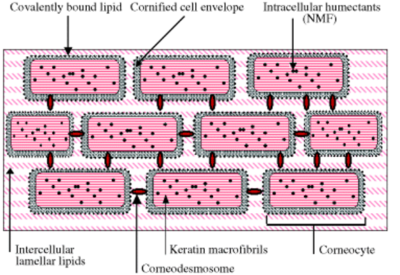
A look at the brick-and-mortar concept
Corneocytes are sometimes referred to as your dead skin cells getting ready to shed; however, they’re not exactly dead because they serve a very useful purpose: they act as biosensor, alerting the layers below what’s happening on the surface (this is important to remember when we get to how your skin signals to begin moisturizing itself).
And inside these corneocytes, you’ll find NMFs. They are a complex mixture of water-soluble compounds that mainly include free amino acids, urea, and lactic acid (the latter two being found outside the corneocytes in small amounts), as well as sodium PCA, various sugars and minerals, and peptides.
Here’s a visual of that secret sauce:
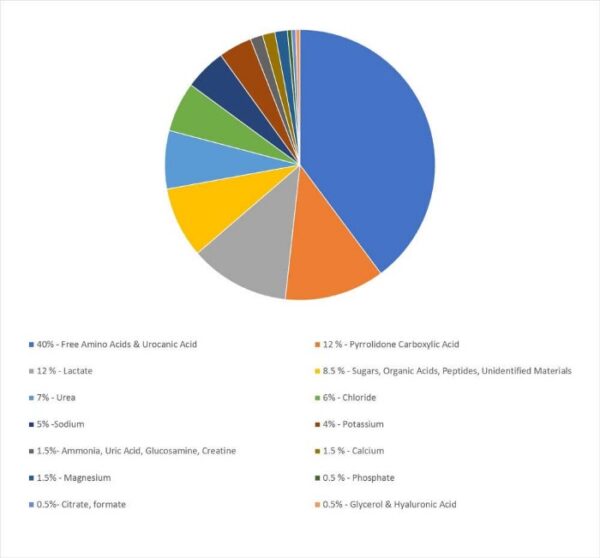
Photo courtesy of Paulina, FromNature.co
Each of these “ingredients” has its job to do. For example:
Urocanic acid: Formed by the breakdown of filaggrin; a natural absorber of UV rays/light
Urea: More than moisturizing, it’s capable of penetrating through the stratum corneum; induces filaggrin gene expression and contributes to antimicrobial defense
Lactate: Influences lipid synthesis of the stratum corneum
NMF makes up about 10% of the mass of the corneocytes and about 20% to 30% of the dry weight of the stratum corneum! Together with the naturally-occurring lipids in the skin, NMFs work to keep skin’s surface robust and supple by constantly absorbing humidity and bringing it into the corneocytes. So in a way, corneocytes are more like a sponge than like a brick!
Even further, NMF is a product of the breakdown process of the protein filaggrin and its precursor profilaggrin.
Filaggrin is a key building block of the corneocyte. It assembles corneocyte proteins, which allow the skin to absorb lots of water without harming the structure of the skin. As the skin hydrates, the corneocytes expand. As water leaves the skin, corneocytes contract. The process is akin to your fingers pruning when enjoying a long bath. Once the water leaves your fingers, everything goes back to normal without any harm done!
This conversion of filaggrin to NMF is controlled by the water activity within the corneocyte. The complete breakdown can only happen in mature corneocytes, which takes at least 28 days. Mature corneocytes are able to withstand the tremendous osmotic pressure of filaggrin-to-NMF breakdown.
Yeah, it’s an important job. And filaggrin mutation—that is, skin not producing enough—reverberates consequences that are quite obvious (but more on that later.)
NMF is essential for more than just skin hydration and elasticity but also barrier homeostasis and shedding (desquamation).
In fact, it’s critical for the acidification of the skin and thus, your skin’s pH and proper enzyme activity. That is, in turn, essential for the breakdown and shedding (aka desquamation) of the skin cells. All the barriers in the stratum corneum work in tandem, and if one barrier goes down, they all suffer. Read about the acid mantle and acidification in the skin here.
NMF and Your Environment
NMF is so vital to this brick-and-mortar that is your outer layer because, in essence, it’s full of ultra-effective humectants—AKA water-attracting molecules. As we mentioned, they absorb atmospheric water together with water diffusing out from the skin and dissolving in their own water of hydration.
NMF can also save that moisture for a not-so-rainy day—like if you’re vacationing in a dry climate or traveling in a pressurized cabin of an airplane. Remember I mentioned your skin is equipped with “tech” to signal the right response in your skin? Those dry-air scenarios are big triggers that your skin needs moisture. Your skin will quickly respond by generating NMF to keep your skin soft and supple in any climate.
Think of your skin as the ultimate meteorologist—it knows what kind of environment it is in and how to react. On the other hand, if you go to hot and humid Florida, NMF signals will turn off because you’ll be getting all the moisture you need from the humid atmosphere!
It’s important to understand that your skin reacts to these changes in the moment. If you’ve traveled to a drier climate and your skin freaks out, meaning it gets dry and flaky and takes its sweet time getting back to normal, that’s a tell-tale sign of a low barrier resistance and that it’ll need some NMF topical love (recommendations below).
NMF production occurs closer to the stratum corneum surface, but under conditions with low humidity, NMF occurs deeper within the stratum corneum so not having a resilient barrier means slower bounce-back times.
Other reasons why your skin doesn’t produce enough NMF…
Age: Slower bounceback times can also be affected by age and sex, as older adults, especially women having undergone menopause, aren’t producing as many moisturizing hormones as say, her younger counterpart.
Cleansers: Routine exposure to drying cleansing agents in generic and sometimes clinical skincare products can deplete the skin’s natural moisturizing factors, leading to visibly dry, tight-feeling, flaky skin.
Sun: Overexposure to UV rays have also been reported to deplete your skin of its NMF.
Inflammatory skin conditions: Lastly, but definitely not least, reduced levels of NMF have been found in disorders such as atopic dermatitis, psoriasis, ichthyosis, and xerosis (generalized dry skin). It stems from loss-of-function mutations in the gene encoding the protein filaggrin, which leads to defective production of filaggrin. Without this profilaggrin-filaggrin-NMF conversion happening, your skin loses out on all those lovely breakdown products.
This halt in NMF production truly affects those with atopic dermatitis. Skin with less NMF is more likely to have staph and other bacteria bond to the corneocytes—hence why atopic dermatitis sufferers get frequent staph infections. They’re also more at-risk for developing skin cancer because the skin can’t generate one of the components of NMF that’s responsible for UV filtration.
Contrary to popular belief, drinking water is not enough to replenish NMF and water in the corneocytes. Our bodies work hard to maintain the perfect water balance inside our cells and maintain a range of salt concentration for optimal function—and, subsequently, quickly rid the blood and skin cells of any excess. So too much water intake can actually throw that out of balance.
On that same note, too much use of facial mists, bath soaks, and quick face rinses can also become a culprit. NMF components are water-soluble, which means they are easily leached from the cells with water contact, making the skin drier.
Plus, from a corneotherapeutic perspective, we understand that the skin barrier is like a sturdy roof defending your home from external conditions. If you have a leaky roof, it doesn’t matter how much you try to fix the interior, a leaky roof will always leave you exposed and unprotected!
Ways to Improve NMF Quantity
Balanced hydration is maintained based on many internal and external factors, so a skin analysis from a certified dermaviduals corneotherapist is crucial.
However, the level of Natural Moisturizing Factor in epidermis decreases with age, so even if you don’t need to replenish it now, almost everyone will experience some form of dryness later on in life. Luckily, many NMF ingredients can be formulated.
Our signature ingredient, DMS, mimics your skin barrier to repair a damaged outer layer and nourish your skin with nutrients it understands (not like emulsifiers, fragrances and mineral oils you see in common cleansers and moisturizers).
All our DMS products help with the generation of key components of Natural Moisturizing Factor to regulate stratum corneum acidification, proper cohesion, and integrity of the skin for a replenished “mortar.”
We also carry Novrithen with DMS, with its high content of urea, Hyaluronic Acid, a naturally occurring humectant, D-Panthenol and our NMF Serum to bring moisturization back where it belongs.
Dermaviduals has a new, exciting product launching this summer—EGCG, the ideal active ingredient to generate filaggrin in the skin. This therapeutic liposome has been shown to help treat inflammatory skin conditions, alopecia, anti-aging, UV protection and pre-cancerous lesions, and dry skin.
Are you a clinic in New York state treating patients with dry skin? Find out more about our new products and prestigious corneotherapeutic skin care line by calling 1-888-753-2231.


